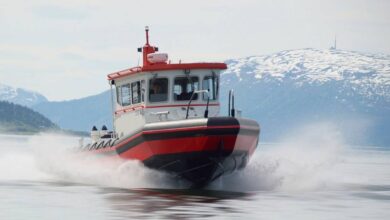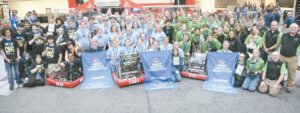UCF lab hosts NASA challenge, but ‘Lunar Knights’ robotics club has rough go – Orlando Sentinel

UCF’s robot looked the part but couldn’t do the job in the end.
The Lunar Knights robotics club was one of 43 university teams taking part in NASA’s 2024 Lunabotics Challenge on Tuesday on the final day of the first round of competition at the UCF’s Exolith Lab near the Orlando campus.
“The first time I walked in here, it was like a kid in a candy store. It was just like Disney World,” said UCF’s Samentha Simmons, 30, a computer science major and software engineer ahead of her teammates’ attempt. “I’ve always wanted to be in robotics and aerospace, so the second I walked in here, seeing all the teams and seeing all the different designs, and knowing it was all part of NASA too, it was the most amazing feeling in the world.”
The goal for each team was to have its robotic rover navigate the obstacles of simulated moon terrain cooked up by the lab and create a berm of lunar regolith. In other words, dig up moon dirt and build a pile.
Four members of each team donned white scrubs with booties on their feet and masks to enter the arena, a giant sandbox made up of the course rocky grains designed to mirror the lunar south pole.
They had to haul their rover, which can weigh a maximum of 176 pounds, into the staging area where they got five minutes to set up, 15 minutes to dig and five minutes to dust it off. Each team had two chances over the three days of the first round in the arena.
For UCF, though, its second attempt Tuesday was no better than the first. Its rover, about the size of push lawn mower and equipped with bulldozer plow up front, wasn’t budging once placed in the test chamber. It’s the first time the school has competed in the national challenge in years and the first experience for each of the club’s teammates.
After the failure, Simmons laid out the problem.
“The challenge really was with the network and a lot of the interferences we were having. Some were connection issues and then we had a little bit of hardware issues,” she said. “It just kind of fell apart, but we’ve figured some things out. We’re a little more hopeful for sure, and if anything we’re got a huge plan for next year. … Got some high hopes.”
Each year NASA comes up with a different task related to its Artemis plans for missions to the moon and eventually Mars. Some years it’s been focused on drilling, some on earth moving. Future challenges could involve quadcopters or other aspects of exploration.
The top 10 teams from the first round will move on to compete in the final rounds Thursday and Friday at Kennedy Space Center Visitor Complex. They were the University of Illinois at Chicago, University of Utah, New Mexico Institute of Mining and Technology, University of Alabama, Vanderbilt University, University of Nebraska-Lincoln, Iowa State University, Worcester Polytechnic Institute, University of Virginia and Michigan Technological University.
UCF team lead Lee Marshall, 20, a mechanical engineering major, took their rover’s difficulties in stride.
“It was a little intimidating because this is our first year here, so our robot looked a lot different than most of the teams,” he said. “They’ve done it year after year after year, so they know what they’re looking for, but I feel pretty good about what our robot was.”
Marshall said the mechanical and electrical teams worked separately for this year’s efforts, but that will change.
“They really should be working together as one team,” he said noting they will also document everything. “We knew a lot of our stuff in our heads, but it was hard to communicate that to other people. … we’ll be ready to hit her harder next year.”
One team that saw more success on Tuesday was from the University of Arkansas, whose rover sported a graphic that read, “Space is Dirty.” The Razorback team just like UCF had a motionless rover for the first eight minutes of the timed competition before it finally made the slightest of movements, prompting shouts of “yes, yes!” and “wooo!” worthy of a touchdown celebration.
It took another few minutes, but then their rover got to work creating the largest pile of moon regolith of the day so far, and among the top five for the first rounds. The largest piles were approaching one-tenth of a cubic meter, which is a little smaller than an outdoor garbage bag.
Paul Archer, 19, a mechanical engineer at Arkansas, was high-fiving teammates with a force that could burst blood vessels while jumping up and down.
“That’s the longest eight minutes of my life,” he said.
One of the judges for the competition, Abbie Easter, a UCF grad who now works with nonprofit National Center for Simulation based in Orlando, commended the look of their rover.
“Their design is sick,” she said admiring the team’s handiwork. “That’s a very solid berm. … it’s exciting to hear the teams cheer.”
They finished 14th in the competition.
UCF professor Dan Britt, the director at the Exolith Lab said this was the first year it had hosted part of the contest, which before the pandemic was held solely at Kennedy Space Center’s Visitor Complex.
It’s part of the university’s “SpaceU” initiative “so we can do better research. It’s a one-of-a-kind facility in the world,” he said.
For UCF’s Lunar Knights, getting their feet in the sand was the primary goal, Marshall said. The final rankings had them tied for last with 15 other schools that unable to get their rovers working.
“This is completely fresh to us — a brand new team, brand new everything,” Marshall said. “So we weren’t here to win. We were here to see how we could win.”


